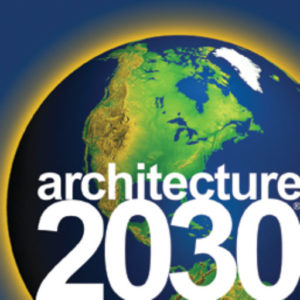Climate plans, a cause for optimism, and the 1.5°C Global Teach-In
August 2020 | announcements
Register today for the CarbonPositive RESET! 1.5°C Global Teach-In.
In COMMON/EDGE, Edward Mazria with some good news about combating climate change: Read the interview
Finally, a Congressional Climate Action Plan!
On June 30, the House Select Committee on the Climate Crisis released a report titled “Solving the Climate Crisis: The Congressional Action Plan for a Clean Energy Economy and a Healthy, Resilient, and Just America.” The more than 500-page document provides a detailed policy and strategy framework as a guide for federal action addressing greenhouse gas emissions reductions. Architecture 2030 and The American Institute of Architects (among many other organizations) were consulted on the policies and actions needed for the built environment to meet the Paris Agreement target of limiting global average temperature to a 1.5°C increase above pre-industrial levels. The Select Committee’s plan provides a framework, not legislation, but could guide federal climate action in the next administration.
Key elements of the Plan include:
- Achieving net-zero emissions from power generation by 2040.
- Incentivizing jurisdictions to immediately adopt a net-zero-emission code based on the Zero Code Renewable Energy Appendix of the 2021 IECC (which was developed by Architecture 2030 and submitted to the IECC by AIA), and mandating adoption by all jurisdictions no later than 2030.
- Increasing funding for the U.S. Forest Service’s Wood Innovation Program to further promote use of mass timber in commercial buildings.
- Highlighting strategies that can be used to reduce embodied carbon emissions in the building sector, including reusing existing materials, using less-emissions-intensive materials, and using tools such as the Embodied Carbon in Construction Calculator (EC3).
- Calling for the expansion of tax credits for the reuse and rehabilitation of existing and historic structures.
- Extending tax credits for residential and commercial solar energy generation, and deductions for commercial building energy efficiency improvements.
- Emphasizing the importance of state, local, and tribal climate emissions reduction targets.
- Incentivizing building energy upgrades, like the electrification of space heating, water heating, and cooking, at invention points like point-of-sale.
Similarly, on July 8, former Vice President Joe Biden and Sen. Bernie Sanders’ Unity Task Force released its climate goals calling for net-zero emissions of new buildings by 2030, and eliminating CO2 emissions from the power sector by 2035. These are the most ambitious U.S. climate plans to date. They also make environmental justice a focus and provide tangible benefits for marginalized communities that often suffer the worst effects of pollution and climate change. Common to both climate plans is reaching U.S. net-zero CO2 emissions as soon as possible—and no later than 2050.
The 2050 phase-out target date has been cited by governments and industry worldwide ever since the Paris Climate Agreement was signed in 2015. However, according to the more recent 2018 IPCC “Special Report: Global Warming of 1.5°C” (IPCC SR15), to ensure a 67% chance of limiting the average global temperature rise to 1.5°C above pre-industrial levels, we must act faster. In 2020, the remaining carbon budget of global emissions permissible while still meeting those goals is approximately 340 GtCO2. To keep within this budget, we must reduce emissions by 50% to 65% by 2030, and completely phase out fossil fuel CO2 emissions by 2040 (and not 2050).
Put simply, immediate action is required. While the legislative priorities outlined in either climate plan would, if enacted, translate into bold action and real shifts in architectural and construction practice, we need to accelerate them—now. Learning how to design, plan, and build for a 1.5°C carbon budget and world is critical. The CarbonPositive RESET! 1.5°C Global Teach-In this September is an opportunity to commit to the immediate and practicable actions for a high probability at limiting warming to 1.5°C.

By attending, you will be joining thousands of others from across the world who are shaping the new built environment and making the 1.5°C targets a reality. Explore the agenda and register today.
ABOUT US
Architecture 2030’s mission is to rapidly transform the built environment from the major contributor of greenhouse gas emissions to a central solution to the climate crisis.



